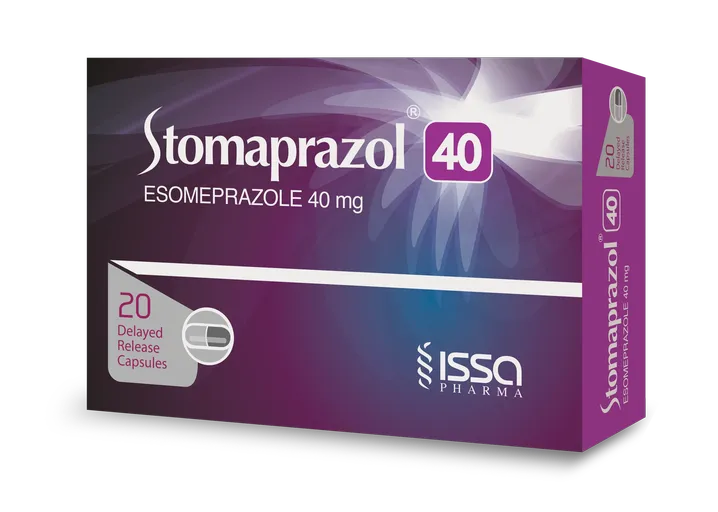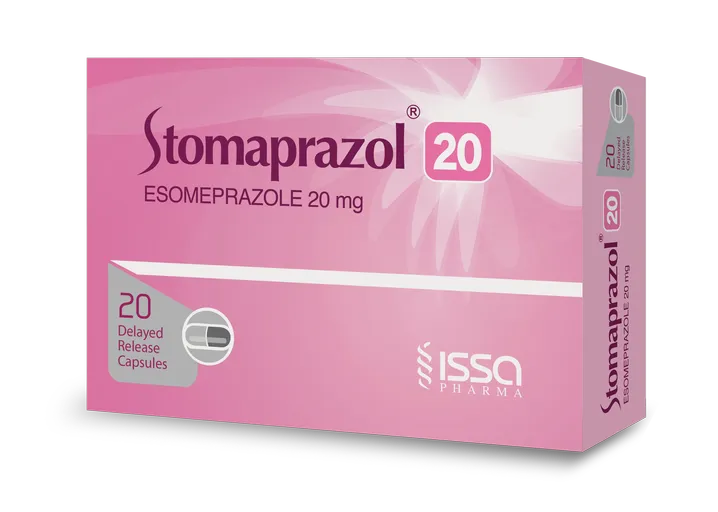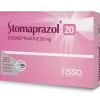COMPOSITION AND EXCIPIENTS
Each capsule of Stomaprazol 20 contains 20 mg Esomeprazole (as delayed release pellets).
Each capsule of Stomaprazol 40 contains 40 mg Esomeprazole (as delayed release pellets).
MECHANISM OF ACTION
Esomeprazole is a proton pump inhibitor that suppresses gastric acid secretion by specific inhibition of the H+/K+-ATPase in the gastric parietal cell. The S- and R-isomers of omeprazole are protonated and converted in the acidic compartment of the parietal cell forming the active inhibitor, the achiral sulphenamide. By acting specifically on the proton pump, esomeprazole blocks the final step in acid production, thus reducing gastric acidity.
PHARMACOKINETICS
Absorption: After oral administration peak plasma levels (Cmax) occur at approximately 1.5 hours (Tmax). The Cmax increases proportionally when the dose is increased. At repeated once-daily dosing with 40 mg, the systemic bioavailability is approximately 90% compared to 64% after a single dose of 40 mg.
Distribution: Esomeprazole is 97% bound to plasma proteins.
Metabolism: Esomeprazole is extensively metabolized in the liver by the cytochrome P450 (CYP) enzyme system.
Excretion: The plasma elimination half-life of esomeprazole is approximately 1 to 1.5 hours. Less than 1% of parent drug is excreted in the urine. Approximately 80% of an oral dose of esomeprazole is excreted as inactive metabolites in the urine, and the remainder is found as inactive metabolites in the feces.
INDICATIONS
Treatment of Gastroesophageal Reflux Disease (GERD):
- Healing of Erosive Esophagitis: for the short-term treatment (4 to 8 weeks) in the healing and symptomatic resolution of diagnostically confirmed erosive esophagitis. For those patients who have not healed after 4 to 8 weeks of treatment, an additional 4 to 8 week course may be considered. In infants 1 month to less than 1 year, esomeprazole magnesium delayed-release capsules are indicated for short-term treatment (up to 6 weeks) of erosive esophagitis due to acid-mediated GERD.
- Maintenance of Healing of Erosive Esophagitis: to maintain symptom resolution and healing of erosive esophagitis. Controlled studies do not extend beyond 6 months.
- Symptomatic Gastroesophageal Reflux Disease: for short-term treatment (4 to 8 weeks) of heartburn and other symptoms associated with GERD in adults and children 1 year or older.
Risk Reduction of NSAID-Associated Gastric Ulcer: for the reduction in the occurrence of gastric ulcers associated with continuous NSAID therapy in patients at risk for developing gastric ulcers. Patients are considered to be at risk due to their age (≥ 60) and/or documented history of gastric ulcers. Controlled studies do not extend beyond 6 months.
Pathological Hypersecretory Conditions Including Zollinger-Ellison Syndrome: for the long-term treatment.
CONTRAINDICATIONS
It is contraindicated in patients with known hypersensitivity to substituted benzimidazoles or to any component of the formulation.
WARNINGS AND PRECAUTIONS
- Symptomatic response to therapy with esomeprazole magnesium does not preclude the presence of gastric malignancy.
- Atrophic gastritis has been noted occasionally in gastric corpus biopsies from patients treated long-term with omeprazole, of which esomeprazole is an enantiomer.
- Acute interstitial nephritis has been observed in patients taking PPIs including esomeprazole magnesium. It may occur at any point during therapy and is generally attributed to an idiopathic hypersensitivity reaction. The drug should be discontinued if acute interstitial nephritis develops.
- Daily treatment with any acid-suppressing medications over a long period of time (e.g., longer than 3 years) may lead to malabsorption of vitamin B-12 caused by hypo-or achlorhydria. This diagnosis should be considered if clinical symptoms consistent with vitamin B-12 deficiency are observed.
- Published studies suggest that PPI therapy like esomeprazole magnesium may be associated with an increased risk of Clostridium difficile associated diarrhea, especially in hospitalized patients. This diagnosis should be considered for diarrhea that does not improve. Patients should use the lowest dose and shortest duration of PPI therapy appropriate to the condition being treated.
- Several published observational studies suggest that proton pump inhibitor (PPI) therapy may be associated with an increased risk for osteoporosis-related fractures of the hip, wrist, or spine. The risk of fracture was increased in patients who received high-dose, defined as multiple daily doses, and long-term PPI therapy (a year or longer). Patients should use the lowest dose and shortest duration of PPI therapy appropriate to the condition being treated. Patients at risk for osteoporosis-related fractures should be managed according to established treatment guidelines.
- Hypomagnesemia, symptomatic and asymptomatic, has been reported rarely in patients treated with PPIs for at least three months, in most cases after a year of therapy. In most patients, treatment of hypomagnesemia required magnesium replacement and discontinuation of the PPI. For patients expected to be on prolonged treatment or who take PPIs with medications such as digoxin or drugs that may cause hypomagnesemia (e.g., diuretics), health care professionals may consider monitoring magnesium levels prior to initiation of PPI treatment and periodically.
- Drug-induced decrease in gastric acidity results in enterochromaffin-like cell hyperplasia and increased Serum Chromogranin A levels which may interfere with investigations for neuroendocrine tumors.
DRUG INTERACTIONS
Interference with Antiretroviral Therapy: Concomitant use of atazanavir and nelfinavir with proton pump inhibitors is not recommended. Co-administration of atazanavir with proton pump inhibitors is expected to substantially decrease atazanavir plasma concentrations and may result in a loss of therapeutic effect and the development of drug resistance. Co-administration of saquinavir with proton pump inhibitors is expected to increase saquinavir concentrations, which may increase toxicity and require dose reduction.
Tacrolimus: Concomitant administration of esomeprazole and tacrolimus may increase the serum levels of tacrolimus.
Drugs for Which Gastric pH Can Affect Bioavailability: Due to its effects on gastric acid secretion, esomeprazole can reduce the absorption of drugs where gastric pH is an important determinant of their bioavailability. Like with other drugs that decrease the intragastric acidity, the absorption of drugs such as ketoconazole, atazanavir, iron salts, erlotinib, and mycophenolatemofetil (MMF) can decrease, while the absorption of drugs such as digoxin can increase during treatment with esomeprazole.
Co-administration of digoxin with esomeprazole is expected to increase the systemic exposure of digoxin. Therefore, patients may need to be monitored when digoxin is taken concomitantly with esomeprazole.
Co-administration of omeprazole in healthy subjects and in transplant patients receiving MMF has been reported to reduce the exposure to the active metabolite. Use esomeprazole with caution in transplant patients receiving MMF.
Effects on Hepatic Metabolism/Cytochrome P-450 Pathways: Esomeprazole is extensively metabolized in the liver by CYP2C19 and CYP3A4. Patients treated with proton pump inhibitors and warfarin concomitantly may need to be monitored for increases in INR and prothrombin time.
Esomeprazole may potentially interfere with CYP2C19, the major esomeprazole metabolizing enzyme. Coadministration of esomeprazole 30 mg and diazepam, a CYP2C19 substrate, resulted in a 45% decrease in clearance of diazepam.
Co-administration of cilostazol with esomeprazole is expected to increase concentrations of cilostazol and its active metabolite. Therefore a dose reduction of cilostazol from 100 mg twice daily to 50 mg twice daily should be considered.
Concomitant administration of esomeprazole and a combined inhibitor of CYP2C19 and CYP3A4, such as voriconazole, may result in more than doubling of the esomeprazole exposure. Dose adjustment of esomeprazole is not normally required. However, in patients with Zollinger-Ellison’s Syndrome, who may require higher dose, adjustment may be considered.
Clarithromycin: Co-administration of esomeprazole, clarithromycin, and amoxicillin has resulted in increases in the plasma levels of esomeprazole and 14-hydroxyclarithromycin.
St. John’s Wort or Rifampin: Drugs which induce CYP2C19 or CYP3A4 (such as St. John’s Wort or rifampin) can substantially decrease esomeprazole concentrations. Avoid concomitant use of esomeprazole magnesium with St. John’s Wort, or rifampin.
Methotrexate: Literature suggests that concomitant use of PPIs with methotrexate may elevate and prolong serum levels of methotrexate and/or its metabolite, possibly leading to methotrexate toxicities. In high-dose methotrexate administration a temporary withdrawal of the PPI may be considered in some patients.
Clopidogrel: Avoid concomitant use of esomeprazole magnesium with clopidogrel and consider alternative anti-platelet therapy. Clopidogrel is a prodrug. The metabolism of clopidogrel to its active metabolite can be impaired by use with concomitant medications, such as esomeprazole, that inhibit CYP2C19 activity.
ADVERSE REACTIONS
Adult:
The most frequently occurring adverse reactions were: headache, diarrhea, Nausea, flatulence, abdominal pain, constipation and dry mouth.
Pediatrics:
Aged 1 to 11 years: the most frequently reported adverse reactions were: diarrhea, headache and somnolence.
Aged 12 to 17 years: the most frequently reported adverse reactions: headache, abdominal pain, diarrhea and nausea.
From birth to <1 year of age: abdominal pain, regurgitation, tachypnea and increased ALT.
Combination Treatment with Amoxicillin and Clarithromycin: Diarrhea, taste perversion and abdominal pain.
Pregnancy:
Teratogenic Effects: Pregnancy Category C.
There are no adequate and well-controlled studies with esomeprazole magnesium in pregnant women, it should be used during pregnancy only if the potential benefit justifies the potential risk to the fetus.
Nursing Mothers:
Esomeprazole is likely present in human milk; Caution should be exercised when esomeprazole magnesium is administered to a nursing woman.
Pediatric Use:
The safety and effectiveness of esomeprazole magnesium have been established in pediatric patients 1 to 17 years of age for short-term treatment (up to eight weeks) of GERD. The safety and effectiveness of esomeprazole magnesium have been established in pediatric patients 1 month to less than 1 year for short-term treatment (up to 6 weeks) of erosive esophagitis due to acid-mediated GERD. However, the safety and effectiveness of esomeprazole magnesium have not been established in patients less than 1 month of age.
Geriatric Use:
No overall differences in safety and efficacy were observed between the elderly and younger individuals.
DOSAGE AND ADMINISTRATION
The drug should be taken at least one hour before meals
Delayed-Release Capsule can be swallowed whole or can be opened and mixed with applesauce and it shouldn’t be hot and should be soft enough to be swallowed without chewing, the mixture shouldn’t store for future use. The pellets should not be chewed or crushed.
For patients who have a nasogastric tube: the capsules can be opened and the only intact granules should be emptied into a 60 mL catheter tipped syringe and mixed with 50 mL of water. Replace the plunger and shake the syringe vigorously for 15 seconds. Hold the syringe with the tip up and check for granules remaining in the tip. Attach the syringe to a nasogastric tube and deliver the contents through the nasogastric tube, then nasogastric tube should be flushed with additional water.
Recommended Dosage Schedule:
Indication | Dose | Frequency | |||
Gastroesophageal Reflux Disease (GERD) | Healing of Erosive Esophagitis | 20 mg or 40 mg | Once Daily for 4 to 8 Weeks The majority of patients are healed within 4 to 8 weeks. For patients who do not heal after 4 to 8 weeks, an additional 4 to 8 weeks of treatment may be considered. | ||
Maintenance of Healing of Erosive Esophagitis | 20 mg | Once Daily (Controlled studies did not extend beyond six months) | |||
Symptomatic Gastroesophageal Reflux Disease | 20 mg | Once Daily for 4 Weeks If symptoms do not resolve completely after 4 weeks, an additional 4 weeks of treatment may be considered. | |||
Pediatric GERD | 12 to 17 Year Olds | Healing of Erosive Esophagitis | 20 mg or 40 mg | Once Daily for 4 to 8 Weeks | |
Symptomatic GERD | 20 mg | Once Daily for 4 Weeks | |||
1 to 11 Year Olds ( Doses over 1 mg/kg/day have not been studied) | Short-term Treatment of Symptomatic GERD | 10 mg | Once Daily for up to 8 Weeks | ||
Healing of Erosive Esophagitis | weight < 20 kg | 10 mg | Once Daily for 8 Weeks | ||
weight ≥ 20 kg | 10 mg or 20 mg | Once Daily for 8 Weeks | |||
1 month to < 1 year old Doses over 1.33 mg/kg/day have not been studied. | Erosive esophagitis due to acid- mediated GERD | Weight 3 kg to 5 kg | 2.5 mg | Once Daily for up to 6 Weeks | |
Weight > 5 kg to 7.5 kg | 5 mg | Once Daily for up to 6 Weeks | |||
weight >7.5 kg to 12 kg | 10 mg | Once Daily for up to 6 Weeks | |||
Risk Reduction of NSAID- Associated Gastric Ulcer | 20 mg or 40 mg | Once Daily for up to 6 months (Controlled studies did not extend beyond six months) | |||
Pathological Hypersecretory Conditions Including Zollinger-Ellison Syndrome | 40 mg | Twice Daily The dosage in each condition varies with the individual patient. Dosage regimens should be adjusted to individual patient needs | |||
Hepatic Insufficiency:
- Mild to moderate liver impairment: no dosage adjustment is necessary.
- Severe liver impairment: a dose of 20 mg of esomeprazole should not be exceeded.
OVERDOSAGE
The symptoms described with overdose are transient; manifestations were variable, but included confusion, drowsiness, blurred vision, tachycardia, nausea, diaphoresis, flushing, headache, dry mouth, and other adverse reactions.
No specific antidote for esomeprazole is known, it is not expected to be removed by dialysis. In the event of overdosage, treatment should be symptomatic and supportive.
STORAGE CONDITIONS
Store at 25 ̊C, away from reach of children.
PACKAGING
Stomaprazol (20 – 40) mg is supplied as blister strips (Aluminum – Clear P.V.D.C), each strip contains 10 capsules and each pack contains 2 or 3 strips with enclosed leaflet (20 or 30 capsules per pack).



